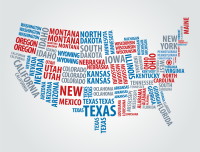Categories
- Additional Insured
- ChildrensProducts
- Claims Made
- Cyber Insurance
- Dietary Supplements and Nutraceuticals
- Ecigarettes
- Firearms Insurance
- Food Products
- Foreign Products Liability
- Foreseeable Misuse
- Frivolous Lawsuits
- General Liability
- Industrial
- Infographics
- Intellectual Property
- Looking ahead
- Marijuana Liability
- Medical Products
- Mutual Indemnification
- Nano Technology
- News
- Online Sellers Insurance Requirements
- Outsourcing
- Piercing The Corporate Veil
- Pollution Liability
- Product liability
- Product Recall
- Retail Chain Store
- Start-Up Business
- Statute of Repose
- Surplus Lines Insurance
- Technology
State-to-State Variability: Joint & Several Liability

Part 1 in a series
If your business sells products in the U.S., Joint and Several Liability is the best example of how state laws can impact your business.
In “Why Naming Multiple Defendants in a Lawsuit is Common Practice” I share why plaintiff attorneys name so many defendants in a Product Liability lawsuits. Even if you have only marginal ties to the product responsible for the lawsuit, you’re potentially responsible for paying the lion’s share of the damages – or even all of it.
What kind of law would allow this to happen?
Joint & Several Liability serves to make sure the injured party or plaintiff is able to be made whole. This is so even if one or more of the defendants are unable pay their share of the monetary damages. Critics of Joint and Several Liability refer to this approach as the “deep pocket rule.” This is because of the potential of a Product Liability lawsuit becoming a search for the deepest pockets.
Different approaches from state to state
Over time, tort reform efforts have led to many states limiting the applicability of pure joint and several liability. States currently use one of the following three approaches when distributing the financial liability among defendants:
-
Pure Joint/Several Liability: Each defendant in a Product Liability lawsuit is responsible for the entire amount of the damages. This is so regardless of how much responsibility or liability each defendant had. Currently, 16% of states use Pure Joint and Several Liability, including my fine home state, South Carolina.
-
Pure Several Liability: Each defendant is only liable for a portion of the damages, based on their percentage of responsibility or liability. For example, the manufacturer and designer of a faulty product would have a higher percentage of responsibility or liability than the retail distributor. Currently, 28% of states use use this approach.
-
Modified Joint/Several Liability: This is the midpoint between Pure Joint/Several Liability and Pure Several Liability. It can vary greatly from state to state. Currently, 56% of the states use this approach.
The bottom line
Obviously, life is not fair. The portion of damages a business distributing products in all or most of the 50 states must pay depends on the state where the Product Liability case takes place.
If you want to know which states use Pure Joint & Several Liability, Pure Several Liability or the Modified Joint & Several Liability, simply check this chart.
-
Part 2: State-to-State Variability: Statute of Repose
-
Part 3: State-to-State Variability: Statute of Limitations
-
 Click the Button Below to Get Your
Click the Button Below to Get Your
No-Obligation Quotes from Among the
Top 18 Leading Insurance Carriers Today -
Recent Industry News
- How to Prevent Nuclear Product Liability Verdicts
- Amazon Sellers and Vendors Strategy Including Insurance Requirements
- Walmart Sellers Insurance
- Product Liability Limit Requirements of Online Sellers
- State-by-State Product Liability Analysis of Laws Impacting Businesses
- Children’s Product Liability: Strange Claims and Need for Insurance
- Product Liability vs. Environmental Insurance for the Chemical Industry
- Product Liability in the 3D Printing Industry: New Materials and Their Significance
- Product Liability Concerns in Agricultural Equipment Enhanced with Artificial Intelligence
- Navigate Product Liability in Battery and Solar Industry
Monthly News Archives
